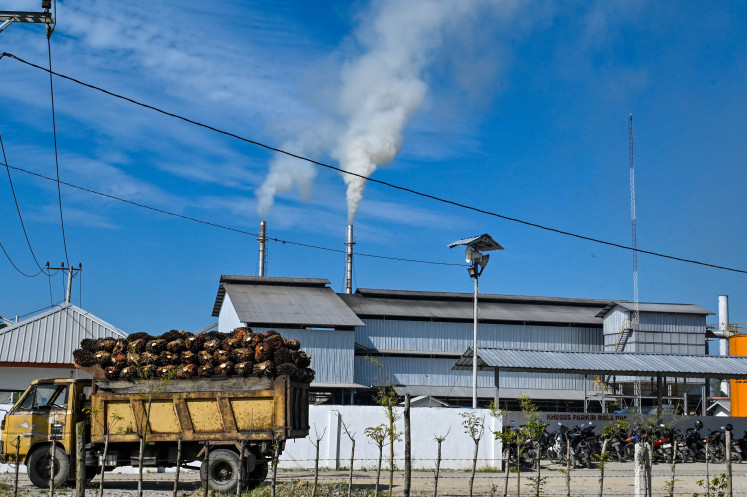Popular Reads
Top Results
Can't find what you're looking for?
View all search resultsPopular Reads
Top Results
Can't find what you're looking for?
View all search resultsSupardjo: Preserving Javanese literature
JP/Ganug Nugroho AdiCourteous, hospitable and modest, Supardjo, born in Kebakkramat in Central Java in 1956, has made a more than modest contribution to the preservation of Javanese culture
Change text size
Gift Premium Articles
to Anyone
J
span class="caption" style="width: 398px;">JP/Ganug Nugroho AdiCourteous, hospitable and modest, Supardjo, born in Kebakkramat in Central Java in 1956, has made a more than modest contribution to the preservation of Javanese culture.
Through Yayasan Sastra, the literature foundation he cofounded with John Paterson, a Javanese culture researcher at Monash University in Australia, Supardjo has transliterated thousands of old manuscripts from the Javanese to the Roman alphabet over the last 15 years.
It’s an intricate job, as the transliteration involves not only a mere alphabetical transformation, but also requires the consideration of the rhyming rules of the relevant texts. According to Supardjo, the old manuscripts are mostly in the form of macapat, or traditional Javanese poetry, so the Roman characters should also follow macapat standards.
“There are 11 to 15 basic types of macapat like Dandanggulo, Asmaradana, Pocung and Sinom, each with its own standards for the number of lines and syllables as well as vocal sounds at the ends of lines,” explained the father of three at Yayasan Sastra on Jl. Jageran in Surakarta.
Anybody transliterating old texts must also understand the content of macapat and be capable of singing the poetry so as not to miss the spirit and purpose of the Javanese language literary works.
“I was born and brought up in a village where wayang kulit [shadow puppet] and macapatan [poetry singing] were our only entertainment. So I’ve been familiar with macapat since childhood,” said the lecturer and chair of the Javanese Literature Department at Sebelas Maret University (UNS) in Surakarta.
His transliterating began in 1996 when he met John Paterson, who was writing his doctoral dissertation on cultural developments in the 19th century in Java. “Mas John needed old manuscripts to complete his dissertation and I happened to own some and romanized them [for him]. Since then, we’ve been cooperating to find other texts,” Supardjo said.
The works of Javanese literature were obtained from collectors, through donations and at flea markets like Triwindu and Sriwedari in Surakarta and markets in Yogyakarta. Between 1996 and 1997, Supardjo said there were still large quantities of Javanese manuscripts available at low prices.
“At that time, a number of old texts cost only tens of thousands of rupiah. Today, one document can cost tens of millions of rupiah. They know these manuscripts are expensive. Actually, we buy them for science, not for resale,” Supardjo emphasized.
The preoccupation with manuscript hunting and transliteration caused Paterson to neglect his dissertation, and Paterson’s money for dissertation writing going to recovering old manuscripts. “Our big collection finally led to the idea of setting up Yayasan Sastra,” said the philology postgraduate alumnus of Padjadjaran University in Bandung.
After 15 years, the foundation has transliterated over 3,000 old manuscripts for a total of over 15 million words. Of all the documents, about 1,300 are now digitized so they can be downloaded from the Internet. “We’re assisted by 30 to 40 casual staffers in the transliteration,” he said.
Supardjo comes from a family with little tradition in the arts. His father, Supardi Djojoredjo, 88, is a retired servicemen and his mother, Marinah, a homemaker. Supardjo’s knowledge of the Javanese alphabet and poetry singing was obtained at school, watching wayang performances and joining macapatan as an elementary and junior high school student.
He studied at the Conservatory High School in the department of pedalangan (shadow puppetry) after finishing junior high. He chose the department because it included the study of Javanese literature along with the Javanese alphabet. After high school, he joined the Javanese Literature and Culture Department at UNS.
“At first, I felt I was alone and abandoned as most of my peers studied at more esteemed schools. In the first few years, I frequently wondered what I was studying Javanese literature for. But my love of the subject kept me going,” he recalled.
During his college years, Supardjo utilized his Javanese literary knowledge to serve as pambiwara or master of ceremonies and was invited to various cities to conduct celebrations. He also opened a Javanese pambiwara school in Surakarta, which has since made headway.
Supardjo said his foundation’s collection begins in the 19th century and extends to the early 20th, and comprises the works of men of letters from the Mangkunegaran and Kasunanan Courts of Surakarta, including Yosodipura II, Ronggowarsito, Padmosusastro and Sasradiningrat IV.
Apart from Javanese poetry, there are also handwritten, printed and typed prose passages. The oldest manuscripts were written in 1810, important works such as Serat Damarwulan, Babad Majapahit, Srikandi Meguru Manah and Sembadra Larung, which are in their original form.
“Old texts deal with not only arts but also religion, agriculture, drugs, philosophy and other topics.
“Some even give instructions on how to grow paddy,” noted the bespectacled man.
Supardjo said the transliteration was meant to help people unfamiliar with Javanese characters understand the content of the texts. As time goes on, fewer and fewer people can read and write in the Javanese alphabet, and Yayasan Sastra is doing a great service in making Javanese texts accessible to those who cannot read Javanese. The foundation also preserves the manuscripts by cleaning, fumigating and repairing damaged pages.
“We also want to allow the public to access the documents. It’s no use maintaining this collection in good condition without benefiting society. We only try to facilitate literary study by those interested in Javanese culture,” said the husband of Sri Wahyuni.
This has been difficult as Yayasan Sastra is a nonprofit foundation. They have not received support from the Surakarta government or any other groups.
“So far, the foundation has been personally financed by Mas John. Only this year have we submitted a funding request to the National Library. Hopefully, this will be approved soon,” Supardjo said.










